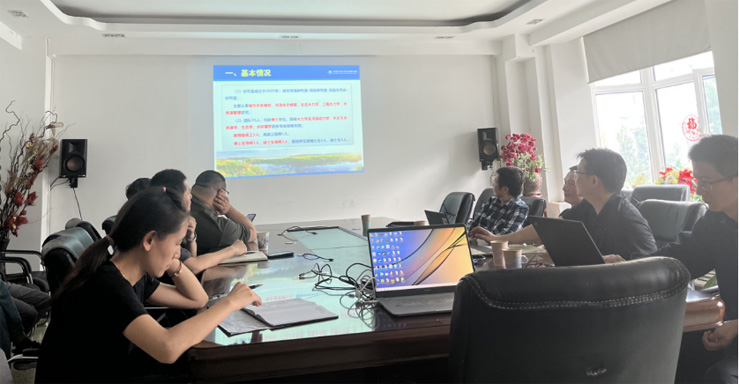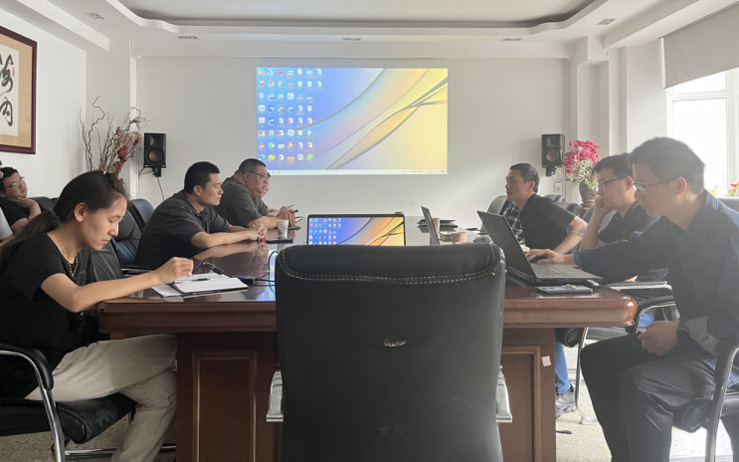

On the afternoon of June 9th, experts from the Department of Institute of Hydraulics of IWHR had a technical exchange and discussion on river and lake governance in the BIC.

Conference Site: Introduce the basic information of the company
At the beginning of the meeting, BIC communicated with the Department of Institute. BIC is a state-owned company subordinated to China Institute of Water Resources and Hydropower research (IWHR). At present, BIC has applied several patents successfully targeting the “Integral Type Hydraulic Elevator Dam” and its new structures and technologies. BIC mainly works in water conservancy, small-scale hydro-power and water treatment fields, especially in the research of containerized water treatment plant and sea water desalination system and the construction of engineering projects such as hydraulic elevator dam, rubber dam, capable of undertaking turn-key project including engineering investigation and design, construction, supervision, consulting and evaluation, monitoring and inspection, installation and commissioning. These self-researched scientific achievements have been used in hundreds of projects nationally and abroad, achieving well economic efficiency and social efficiency.
The Department of Hydraulics was one of the earliest established Department in IWHR. Over the past decades, the Department of Hydraulics has now developed into a comprehensive research center of hydraulics, characterized by energering hydraulics, thermal/nuclear energering hydraulics, hydraulic control and river ice, estuarine/coastal dynamics and environmental hydraulics, ecology hydraulics, etc. The main research fileds include energering hydraulics, thermal/nuclear energering hydraulics, Hydraulic Control and River Ice Study, Estuarine/Coastal Dynamics And Environmental Hydraulics, and Ecology Hydraulics.

The expert introduced the basic situation of the Department of Hydraulics.
Afterwards, the experts took "Hundred Lake City" --Daqing as an example, around the overall layout, water pollution prevention and control, ecological restoration measures for rivers and lakes, river and lake landscape and water culture. Using the methods of "diverting water to flush out sewage and purify plants", improve the water quality of rivers and lakes, achieve ecological restoration of rivers and lakes. Thereby reducing the island effect of wildlife habitats, ensuring the safe migration of wild animals, and reducing the interference caused by human activities to the normal reproduction of wild animals.

Conference Site
In April 2020, the Ministry of Water Resources issued the "Guiding Opinions on Doing a Good Job in the Determination and Guarantee of Ecological Flows in Rivers and Lakes", in response and prominent contradiction in living and production ecological water use in some river basins in China, river stoppages, lake shrinkage, and ecological functions of rivers and lakes. According to the overall deployment of ecological civilization construction, combined with the actual management, the guiding ideology, basic principles and main goals for the determination and protection of ecological flow in rivers and lakes have been clarified.

In March 2022, the Ministry of Water Resources formulated the “Key Points of River and Lake Management in 2022”. The main points of river and lake management in 2022 are mainly divided into five aspects: strengthening the river and lake chief system, strengthening the spatial control of river and lake water shoreline, strengthening the river sand mining management, strengthening the construction of smart rivers and lakes, and comprehensively strengthening the party building.

The seminar lasted for more than two hours, the wonderful speech aroused strong sympathy among the participants and gave warm applause to the experts. Through this exchange and interaction, not only shared each other’s views on river and lake governance, but also exchanged new concepts and practices in water conservancy technology and management under the new situation and new challenges; making contributions to building sustainable urban development and ensuring the ecological environment.